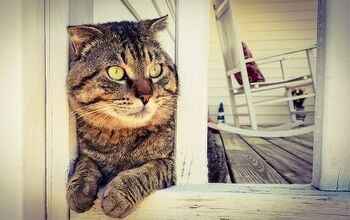5 Fascinating Facts About Cat Whiskers

Cat whiskers: you might think that you know all about them, but there are actually some interesting facts that make them even more fascinating. Check out the information below to learn more about how your cat uses her whiskers every day.
Whiskers, which are also known as tactile hairs, are anywhere from two to three times thicker than the hairs that are found in your cat’s coat. And even though they come out of hair follicles, they are coarser than the rest of the hair on your cat’s body. Plus, they are also embedded three times deeper into your cat’s skin, allowing them to remain connected to the animal’s nervous system. Strategically located, you can find whiskers on different areas of your cat’s face and body, such as the cheeks, above the eyes, and the forelegs.
Related: What Is Feline Whisker Fatigue?
In addition to being deep in the skin, whiskers are sensitive because their follicles feature abundant nerves and blood vessels. The ends of whiskers also have sensory organs that are referred to as proprioceptors. These help provide important sensory input so that a kitty could effectively and safely navigate her environment, and they could even transmit messages about the position of the cat’s body.
Related: Feline Health: Symptoms You Shouldn’t Ignore
The whiskers themselves, however, don’t really feel anything. Instead, they’re used to send information to the body’s sensory cells. Basically, when something brushes against a whisker, the hair will vibrate, thereby stimulating the nerves within the follicle. In this way, a cat could use her whiskers to detect movement, objects, and even the flow of air. The whiskers could even provide a kitty with information on the shape, speed, and size of an object.
Whiskers are so sensitive that, if too much pressure is applied to them, a cat could experience whisker fatigue. This could happen if a kitty is forced to eat out of a food bowl that’s too small.
Take a look at the whiskers on your cat’s cheeks and you might notice that their length corresponds with the width of her body. This helps your cat figure out whether or not she can squeeze into a tight space safely.
Observing the position of your cat’s whiskers could give you insight into how she’s feeling at the moment. For example, if they’re pulled back and flattened against the cheeks, your cat might be mad or frightened. If they’re relaxed, then your kitty might be at ease. But if they’re pointed forward and tense, your pet might be on the hunt or taking in information from the environment.
Overall, cat whiskers are pretty incredible, and they shouldn’t be messed with. Because whiskers are so important to your cat’s health, you shouldn’t cut them, pluck them, or pull on them. And if you happen to find a whisker on your furniture or on the floor, don’t worry, as they do fall out before growing back.

Lisa Selvaggio is a freelance writer and editor, and our resident cats-pert, with certifications in pet nutrition and pet first aid. She enjoys producing content that helps people understand animals better so they can give their pets a safe and happy home.
More by Lisa Selvaggio























